Contract Law (LLB Year 1) Coursework: Katie vs. Leonard Analysis
VerifiedAdded on 2022/11/24
|7
|1759
|467
Homework Assignment
AI Summary
This coursework assignment analyzes a contract law case study involving Katie and Leonard. The assignment begins with an introduction to contract law, emphasizing the importance of valid contracts and the roles of different terms. The core of the assignment focuses on determining the existence of a valid contract between Katie and Leonard, examining key elements such as offer, acceptance, and consideration. The analysis applies legal principles, including the distinction between offers and invitations to treat, the requirements for valid acceptance, and the postal rule. The application section evaluates the communications between Katie and Leonard, determining which communications constitute offers, acceptances, or invitations to treat. The assignment concludes that a valid contract was not formed due to the lack of acceptance of an offer. The assignment also includes a bibliography of used sources, including case laws, books and online resources.
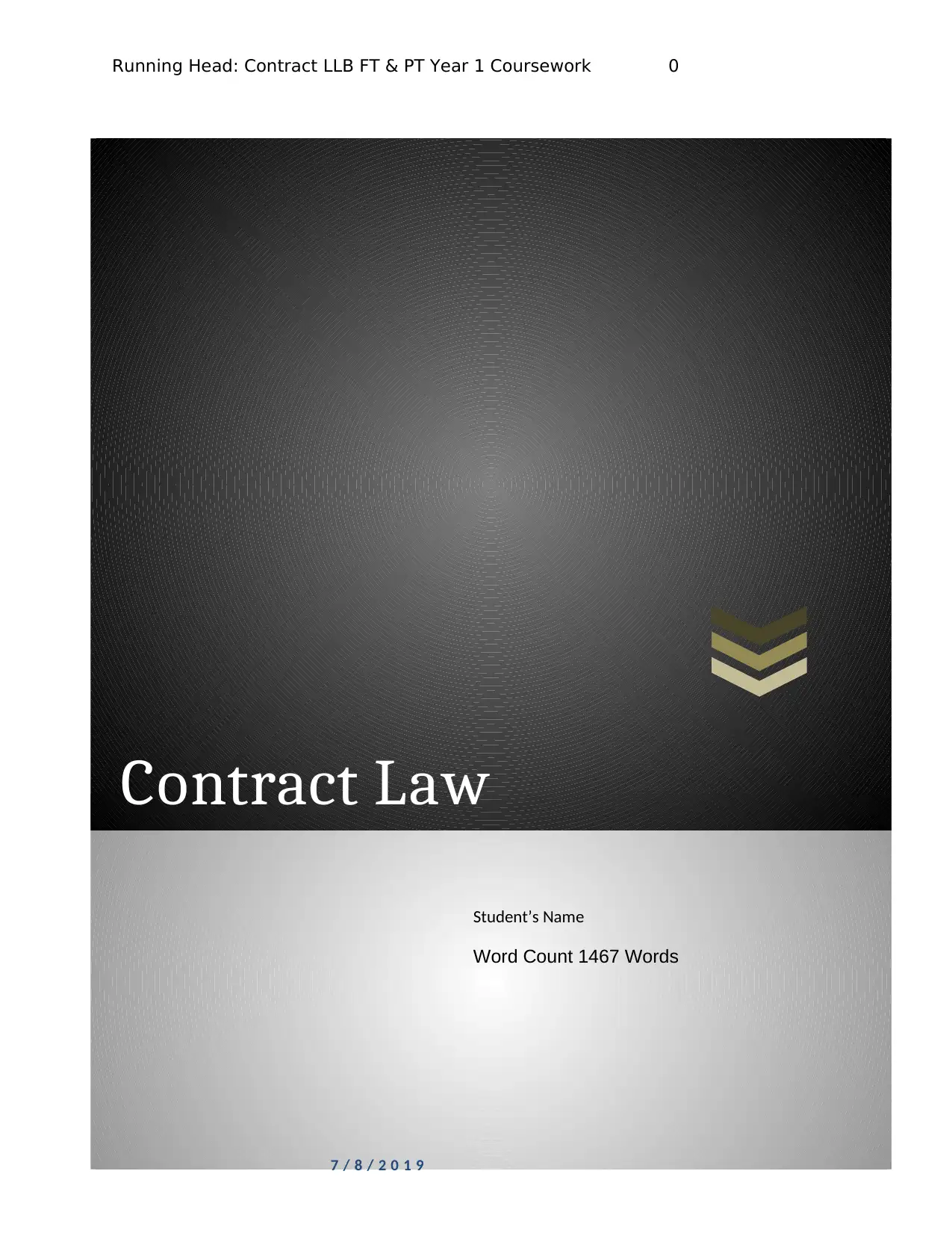
WW
Contract Law
Running Head: Contract LLB FT & PT Year 1 Coursework 0
7 / 8 / 2 0 1 9
Student’s Name
Word Count 1467 Words
Contract Law
Running Head: Contract LLB FT & PT Year 1 Coursework 0
7 / 8 / 2 0 1 9
Student’s Name
Word Count 1467 Words
Paraphrase This Document
Need a fresh take? Get an instant paraphrase of this document with our AI Paraphraser
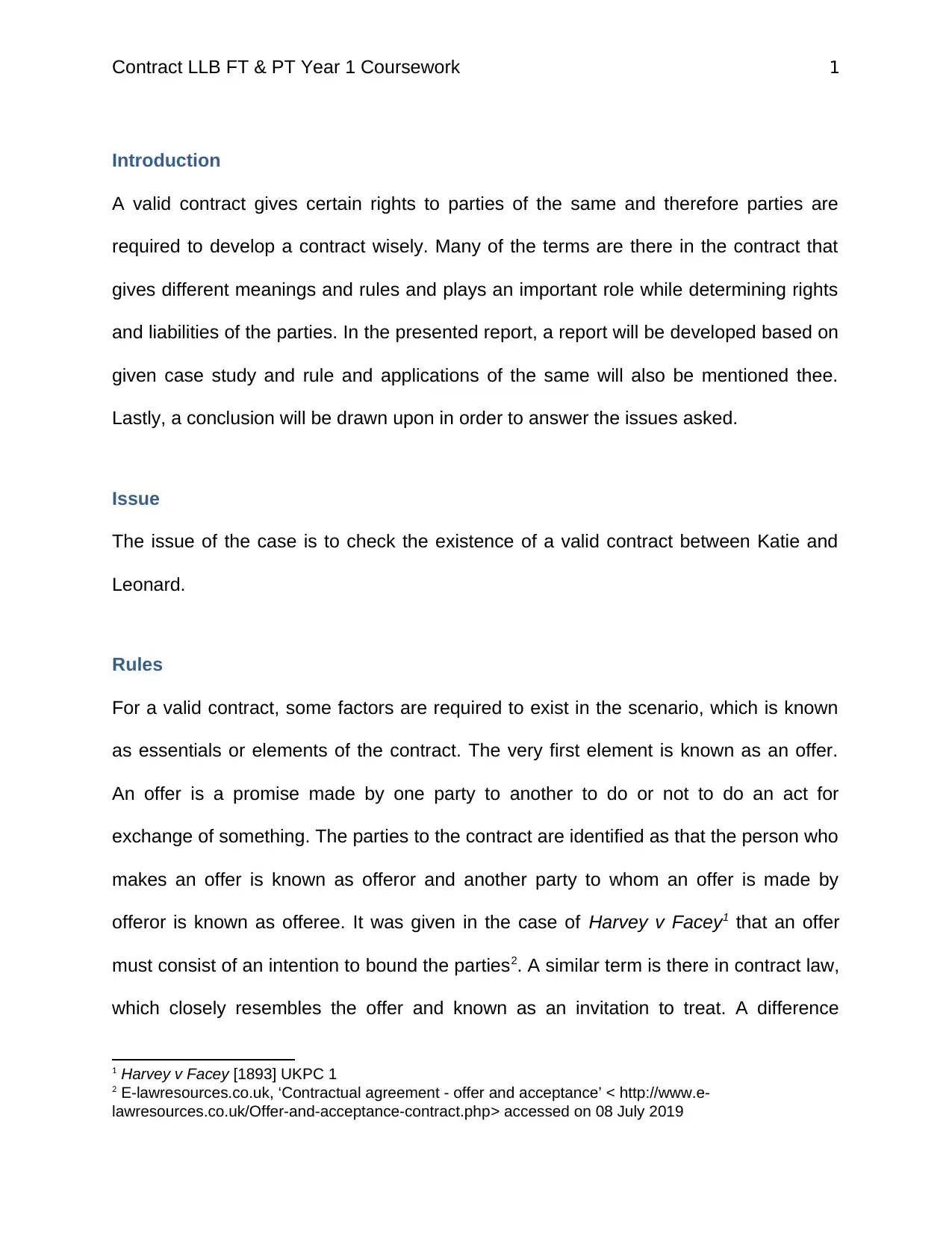
Contract LLB FT & PT Year 1 Coursework 1
Introduction
A valid contract gives certain rights to parties of the same and therefore parties are
required to develop a contract wisely. Many of the terms are there in the contract that
gives different meanings and rules and plays an important role while determining rights
and liabilities of the parties. In the presented report, a report will be developed based on
given case study and rule and applications of the same will also be mentioned thee.
Lastly, a conclusion will be drawn upon in order to answer the issues asked.
Issue
The issue of the case is to check the existence of a valid contract between Katie and
Leonard.
Rules
For a valid contract, some factors are required to exist in the scenario, which is known
as essentials or elements of the contract. The very first element is known as an offer.
An offer is a promise made by one party to another to do or not to do an act for
exchange of something. The parties to the contract are identified as that the person who
makes an offer is known as offeror and another party to whom an offer is made by
offeror is known as offeree. It was given in the case of Harvey v Facey1 that an offer
must consist of an intention to bound the parties2. A similar term is there in contract law,
which closely resembles the offer and known as an invitation to treat. A difference
1 Harvey v Facey [1893] UKPC 1
2 E-lawresources.co.uk, ‘Contractual agreement - offer and acceptance’ < http://www.e-
lawresources.co.uk/Offer-and-acceptance-contract.php> accessed on 08 July 2019
Introduction
A valid contract gives certain rights to parties of the same and therefore parties are
required to develop a contract wisely. Many of the terms are there in the contract that
gives different meanings and rules and plays an important role while determining rights
and liabilities of the parties. In the presented report, a report will be developed based on
given case study and rule and applications of the same will also be mentioned thee.
Lastly, a conclusion will be drawn upon in order to answer the issues asked.
Issue
The issue of the case is to check the existence of a valid contract between Katie and
Leonard.
Rules
For a valid contract, some factors are required to exist in the scenario, which is known
as essentials or elements of the contract. The very first element is known as an offer.
An offer is a promise made by one party to another to do or not to do an act for
exchange of something. The parties to the contract are identified as that the person who
makes an offer is known as offeror and another party to whom an offer is made by
offeror is known as offeree. It was given in the case of Harvey v Facey1 that an offer
must consist of an intention to bound the parties2. A similar term is there in contract law,
which closely resembles the offer and known as an invitation to treat. A difference
1 Harvey v Facey [1893] UKPC 1
2 E-lawresources.co.uk, ‘Contractual agreement - offer and acceptance’ < http://www.e-
lawresources.co.uk/Offer-and-acceptance-contract.php> accessed on 08 July 2019
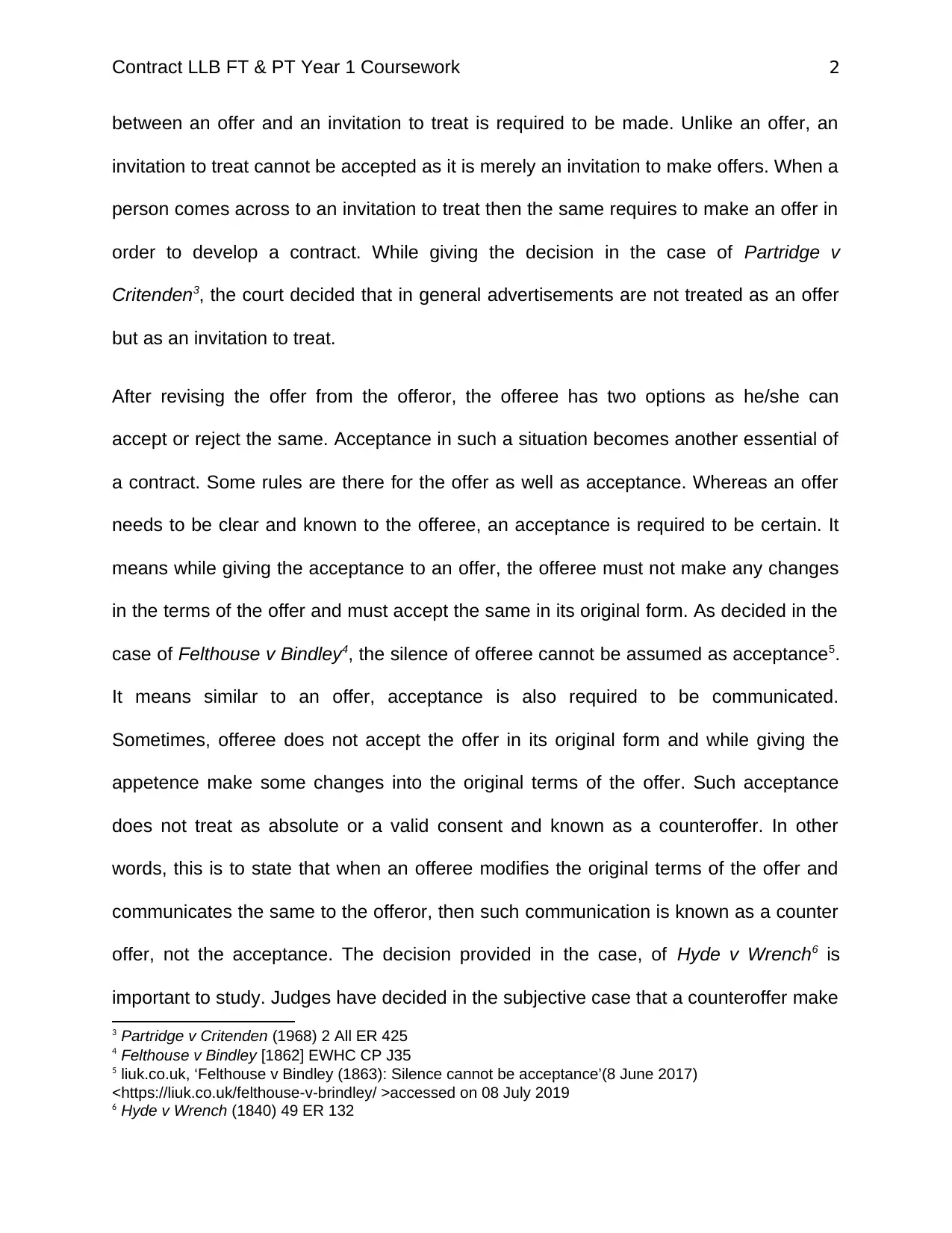
Contract LLB FT & PT Year 1 Coursework 2
between an offer and an invitation to treat is required to be made. Unlike an offer, an
invitation to treat cannot be accepted as it is merely an invitation to make offers. When a
person comes across to an invitation to treat then the same requires to make an offer in
order to develop a contract. While giving the decision in the case of Partridge v
Critenden3, the court decided that in general advertisements are not treated as an offer
but as an invitation to treat.
After revising the offer from the offeror, the offeree has two options as he/she can
accept or reject the same. Acceptance in such a situation becomes another essential of
a contract. Some rules are there for the offer as well as acceptance. Whereas an offer
needs to be clear and known to the offeree, an acceptance is required to be certain. It
means while giving the acceptance to an offer, the offeree must not make any changes
in the terms of the offer and must accept the same in its original form. As decided in the
case of Felthouse v Bindley4, the silence of offeree cannot be assumed as acceptance5.
It means similar to an offer, acceptance is also required to be communicated.
Sometimes, offeree does not accept the offer in its original form and while giving the
appetence make some changes into the original terms of the offer. Such acceptance
does not treat as absolute or a valid consent and known as a counteroffer. In other
words, this is to state that when an offeree modifies the original terms of the offer and
communicates the same to the offeror, then such communication is known as a counter
offer, not the acceptance. The decision provided in the case, of Hyde v Wrench6 is
important to study. Judges have decided in the subjective case that a counteroffer make
3 Partridge v Critenden (1968) 2 All ER 425
4 Felthouse v Bindley [1862] EWHC CP J35
5 liuk.co.uk, ‘Felthouse v Bindley (1863): Silence cannot be acceptance’(8 June 2017)
<https://liuk.co.uk/felthouse-v-brindley/ >accessed on 08 July 2019
6 Hyde v Wrench (1840) 49 ER 132
between an offer and an invitation to treat is required to be made. Unlike an offer, an
invitation to treat cannot be accepted as it is merely an invitation to make offers. When a
person comes across to an invitation to treat then the same requires to make an offer in
order to develop a contract. While giving the decision in the case of Partridge v
Critenden3, the court decided that in general advertisements are not treated as an offer
but as an invitation to treat.
After revising the offer from the offeror, the offeree has two options as he/she can
accept or reject the same. Acceptance in such a situation becomes another essential of
a contract. Some rules are there for the offer as well as acceptance. Whereas an offer
needs to be clear and known to the offeree, an acceptance is required to be certain. It
means while giving the acceptance to an offer, the offeree must not make any changes
in the terms of the offer and must accept the same in its original form. As decided in the
case of Felthouse v Bindley4, the silence of offeree cannot be assumed as acceptance5.
It means similar to an offer, acceptance is also required to be communicated.
Sometimes, offeree does not accept the offer in its original form and while giving the
appetence make some changes into the original terms of the offer. Such acceptance
does not treat as absolute or a valid consent and known as a counteroffer. In other
words, this is to state that when an offeree modifies the original terms of the offer and
communicates the same to the offeror, then such communication is known as a counter
offer, not the acceptance. The decision provided in the case, of Hyde v Wrench6 is
important to study. Judges have decided in the subjective case that a counteroffer make
3 Partridge v Critenden (1968) 2 All ER 425
4 Felthouse v Bindley [1862] EWHC CP J35
5 liuk.co.uk, ‘Felthouse v Bindley (1863): Silence cannot be acceptance’(8 June 2017)
<https://liuk.co.uk/felthouse-v-brindley/ >accessed on 08 July 2019
6 Hyde v Wrench (1840) 49 ER 132
⊘ This is a preview!⊘
Do you want full access?
Subscribe today to unlock all pages.

Trusted by 1+ million students worldwide
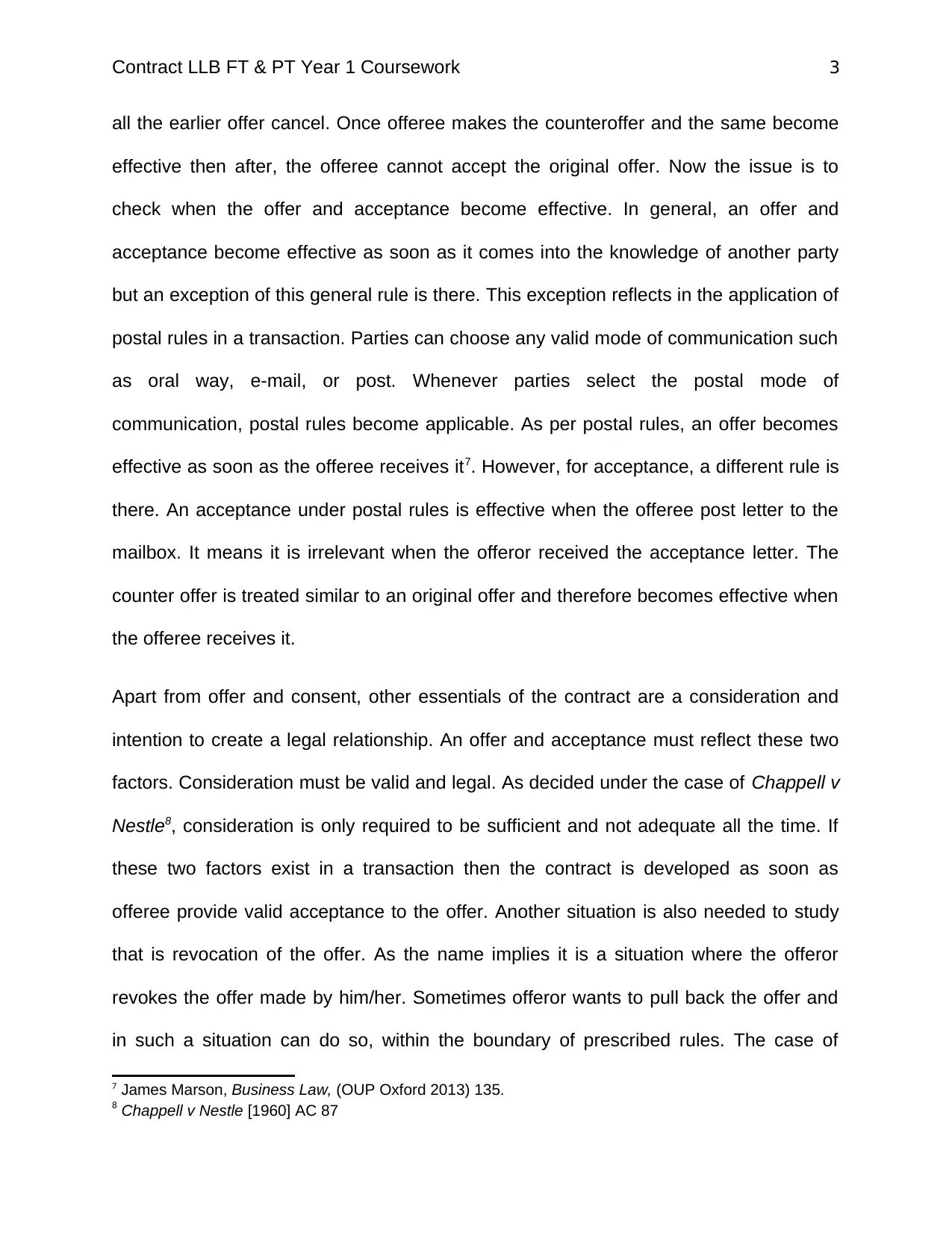
Contract LLB FT & PT Year 1 Coursework 3
all the earlier offer cancel. Once offeree makes the counteroffer and the same become
effective then after, the offeree cannot accept the original offer. Now the issue is to
check when the offer and acceptance become effective. In general, an offer and
acceptance become effective as soon as it comes into the knowledge of another party
but an exception of this general rule is there. This exception reflects in the application of
postal rules in a transaction. Parties can choose any valid mode of communication such
as oral way, e-mail, or post. Whenever parties select the postal mode of
communication, postal rules become applicable. As per postal rules, an offer becomes
effective as soon as the offeree receives it7. However, for acceptance, a different rule is
there. An acceptance under postal rules is effective when the offeree post letter to the
mailbox. It means it is irrelevant when the offeror received the acceptance letter. The
counter offer is treated similar to an original offer and therefore becomes effective when
the offeree receives it.
Apart from offer and consent, other essentials of the contract are a consideration and
intention to create a legal relationship. An offer and acceptance must reflect these two
factors. Consideration must be valid and legal. As decided under the case of Chappell v
Nestle8, consideration is only required to be sufficient and not adequate all the time. If
these two factors exist in a transaction then the contract is developed as soon as
offeree provide valid acceptance to the offer. Another situation is also needed to study
that is revocation of the offer. As the name implies it is a situation where the offeror
revokes the offer made by him/her. Sometimes offeror wants to pull back the offer and
in such a situation can do so, within the boundary of prescribed rules. The case of
7 James Marson, Business Law, (OUP Oxford 2013) 135.
8 Chappell v Nestle [1960] AC 87
all the earlier offer cancel. Once offeree makes the counteroffer and the same become
effective then after, the offeree cannot accept the original offer. Now the issue is to
check when the offer and acceptance become effective. In general, an offer and
acceptance become effective as soon as it comes into the knowledge of another party
but an exception of this general rule is there. This exception reflects in the application of
postal rules in a transaction. Parties can choose any valid mode of communication such
as oral way, e-mail, or post. Whenever parties select the postal mode of
communication, postal rules become applicable. As per postal rules, an offer becomes
effective as soon as the offeree receives it7. However, for acceptance, a different rule is
there. An acceptance under postal rules is effective when the offeree post letter to the
mailbox. It means it is irrelevant when the offeror received the acceptance letter. The
counter offer is treated similar to an original offer and therefore becomes effective when
the offeree receives it.
Apart from offer and consent, other essentials of the contract are a consideration and
intention to create a legal relationship. An offer and acceptance must reflect these two
factors. Consideration must be valid and legal. As decided under the case of Chappell v
Nestle8, consideration is only required to be sufficient and not adequate all the time. If
these two factors exist in a transaction then the contract is developed as soon as
offeree provide valid acceptance to the offer. Another situation is also needed to study
that is revocation of the offer. As the name implies it is a situation where the offeror
revokes the offer made by him/her. Sometimes offeror wants to pull back the offer and
in such a situation can do so, within the boundary of prescribed rules. The case of
7 James Marson, Business Law, (OUP Oxford 2013) 135.
8 Chappell v Nestle [1960] AC 87
Paraphrase This Document
Need a fresh take? Get an instant paraphrase of this document with our AI Paraphraser
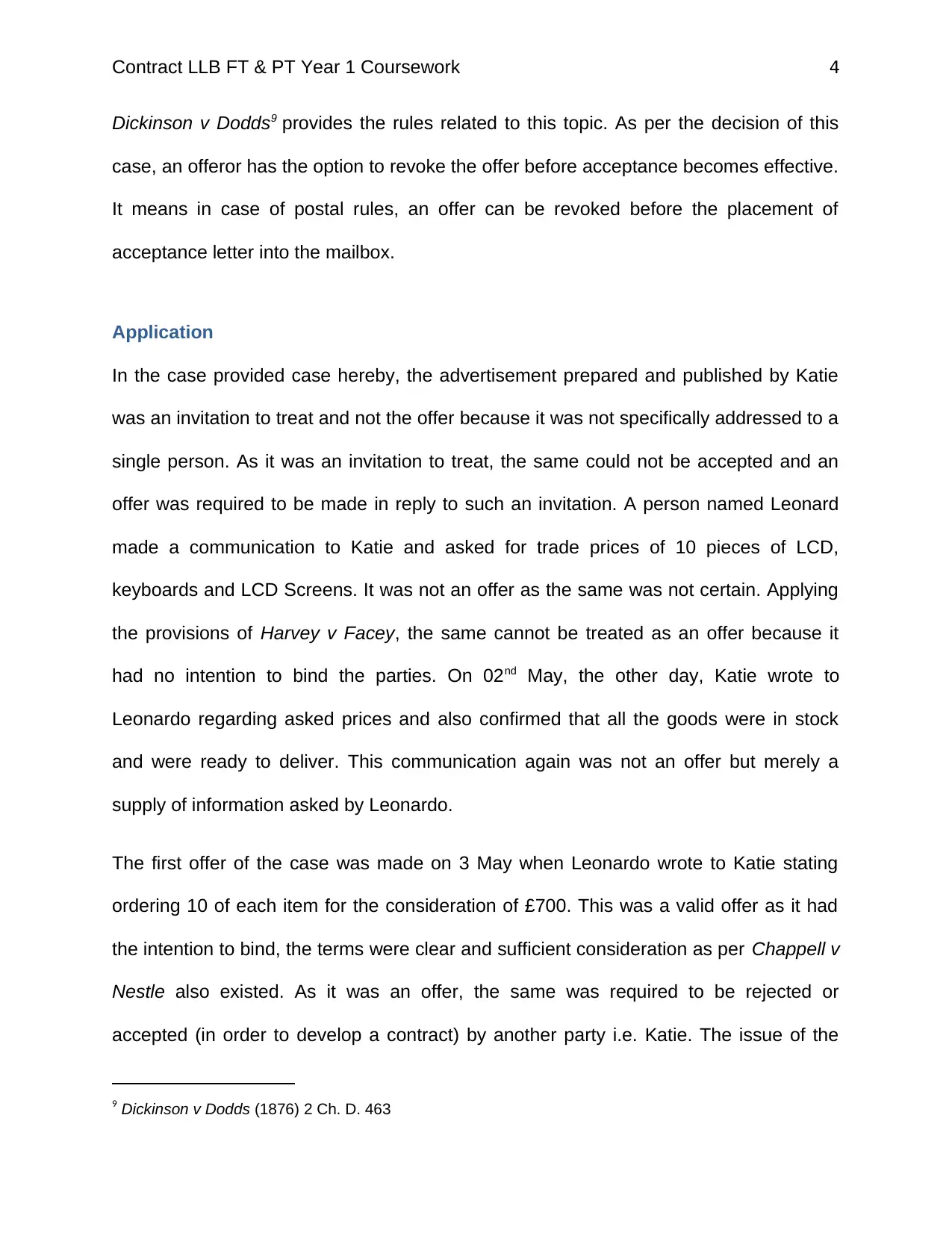
Contract LLB FT & PT Year 1 Coursework 4
Dickinson v Dodds9 provides the rules related to this topic. As per the decision of this
case, an offeror has the option to revoke the offer before acceptance becomes effective.
It means in case of postal rules, an offer can be revoked before the placement of
acceptance letter into the mailbox.
Application
In the case provided case hereby, the advertisement prepared and published by Katie
was an invitation to treat and not the offer because it was not specifically addressed to a
single person. As it was an invitation to treat, the same could not be accepted and an
offer was required to be made in reply to such an invitation. A person named Leonard
made a communication to Katie and asked for trade prices of 10 pieces of LCD,
keyboards and LCD Screens. It was not an offer as the same was not certain. Applying
the provisions of Harvey v Facey, the same cannot be treated as an offer because it
had no intention to bind the parties. On 02nd May, the other day, Katie wrote to
Leonardo regarding asked prices and also confirmed that all the goods were in stock
and were ready to deliver. This communication again was not an offer but merely a
supply of information asked by Leonardo.
The first offer of the case was made on 3 May when Leonardo wrote to Katie stating
ordering 10 of each item for the consideration of £700. This was a valid offer as it had
the intention to bind, the terms were clear and sufficient consideration as per Chappell v
Nestle also existed. As it was an offer, the same was required to be rejected or
accepted (in order to develop a contract) by another party i.e. Katie. The issue of the
9 Dickinson v Dodds (1876) 2 Ch. D. 463
Dickinson v Dodds9 provides the rules related to this topic. As per the decision of this
case, an offeror has the option to revoke the offer before acceptance becomes effective.
It means in case of postal rules, an offer can be revoked before the placement of
acceptance letter into the mailbox.
Application
In the case provided case hereby, the advertisement prepared and published by Katie
was an invitation to treat and not the offer because it was not specifically addressed to a
single person. As it was an invitation to treat, the same could not be accepted and an
offer was required to be made in reply to such an invitation. A person named Leonard
made a communication to Katie and asked for trade prices of 10 pieces of LCD,
keyboards and LCD Screens. It was not an offer as the same was not certain. Applying
the provisions of Harvey v Facey, the same cannot be treated as an offer because it
had no intention to bind the parties. On 02nd May, the other day, Katie wrote to
Leonardo regarding asked prices and also confirmed that all the goods were in stock
and were ready to deliver. This communication again was not an offer but merely a
supply of information asked by Leonardo.
The first offer of the case was made on 3 May when Leonardo wrote to Katie stating
ordering 10 of each item for the consideration of £700. This was a valid offer as it had
the intention to bind, the terms were clear and sufficient consideration as per Chappell v
Nestle also existed. As it was an offer, the same was required to be rejected or
accepted (in order to develop a contract) by another party i.e. Katie. The issue of the
9 Dickinson v Dodds (1876) 2 Ch. D. 463
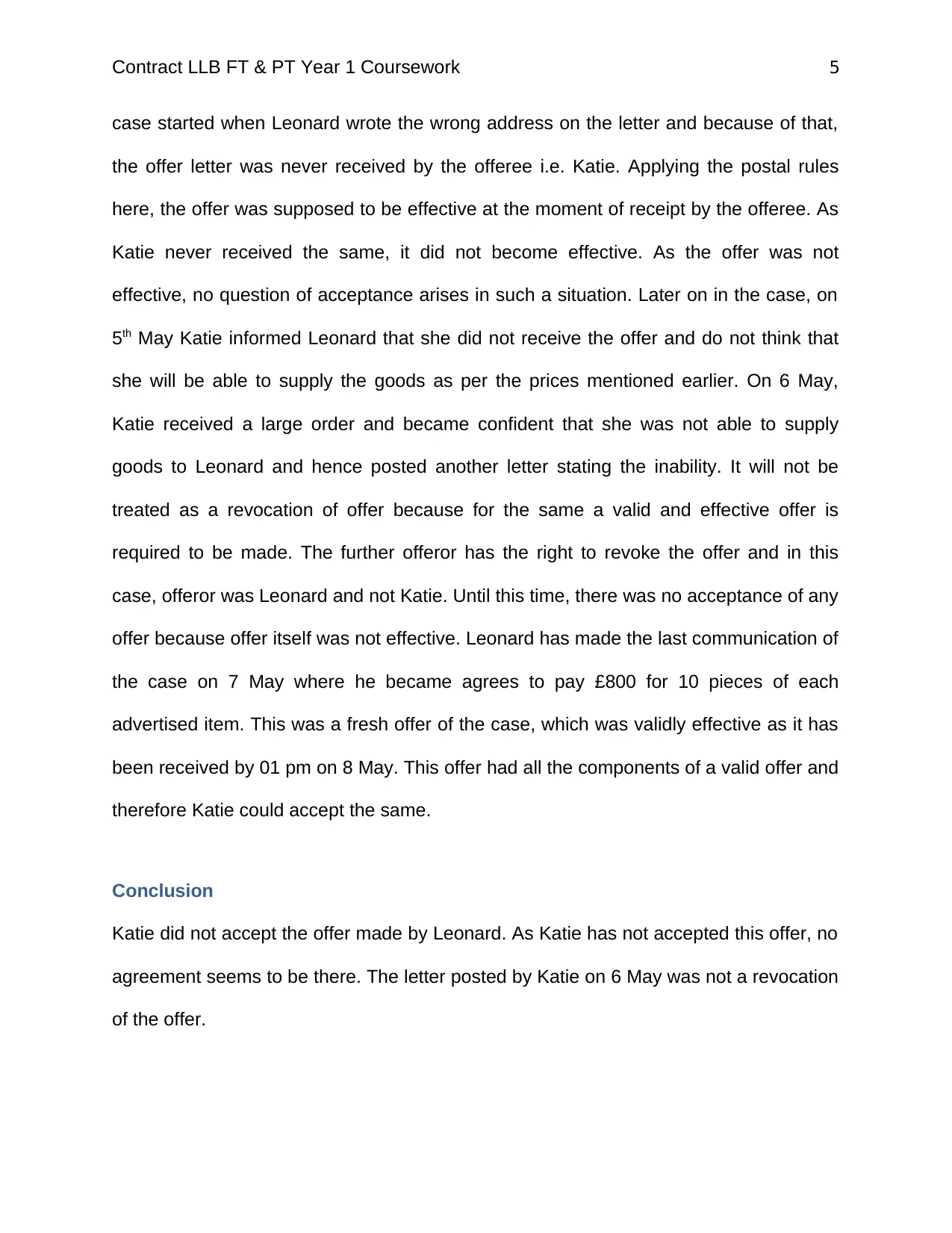
Contract LLB FT & PT Year 1 Coursework 5
case started when Leonard wrote the wrong address on the letter and because of that,
the offer letter was never received by the offeree i.e. Katie. Applying the postal rules
here, the offer was supposed to be effective at the moment of receipt by the offeree. As
Katie never received the same, it did not become effective. As the offer was not
effective, no question of acceptance arises in such a situation. Later on in the case, on
5th May Katie informed Leonard that she did not receive the offer and do not think that
she will be able to supply the goods as per the prices mentioned earlier. On 6 May,
Katie received a large order and became confident that she was not able to supply
goods to Leonard and hence posted another letter stating the inability. It will not be
treated as a revocation of offer because for the same a valid and effective offer is
required to be made. The further offeror has the right to revoke the offer and in this
case, offeror was Leonard and not Katie. Until this time, there was no acceptance of any
offer because offer itself was not effective. Leonard has made the last communication of
the case on 7 May where he became agrees to pay £800 for 10 pieces of each
advertised item. This was a fresh offer of the case, which was validly effective as it has
been received by 01 pm on 8 May. This offer had all the components of a valid offer and
therefore Katie could accept the same.
Conclusion
Katie did not accept the offer made by Leonard. As Katie has not accepted this offer, no
agreement seems to be there. The letter posted by Katie on 6 May was not a revocation
of the offer.
case started when Leonard wrote the wrong address on the letter and because of that,
the offer letter was never received by the offeree i.e. Katie. Applying the postal rules
here, the offer was supposed to be effective at the moment of receipt by the offeree. As
Katie never received the same, it did not become effective. As the offer was not
effective, no question of acceptance arises in such a situation. Later on in the case, on
5th May Katie informed Leonard that she did not receive the offer and do not think that
she will be able to supply the goods as per the prices mentioned earlier. On 6 May,
Katie received a large order and became confident that she was not able to supply
goods to Leonard and hence posted another letter stating the inability. It will not be
treated as a revocation of offer because for the same a valid and effective offer is
required to be made. The further offeror has the right to revoke the offer and in this
case, offeror was Leonard and not Katie. Until this time, there was no acceptance of any
offer because offer itself was not effective. Leonard has made the last communication of
the case on 7 May where he became agrees to pay £800 for 10 pieces of each
advertised item. This was a fresh offer of the case, which was validly effective as it has
been received by 01 pm on 8 May. This offer had all the components of a valid offer and
therefore Katie could accept the same.
Conclusion
Katie did not accept the offer made by Leonard. As Katie has not accepted this offer, no
agreement seems to be there. The letter posted by Katie on 6 May was not a revocation
of the offer.
⊘ This is a preview!⊘
Do you want full access?
Subscribe today to unlock all pages.

Trusted by 1+ million students worldwide
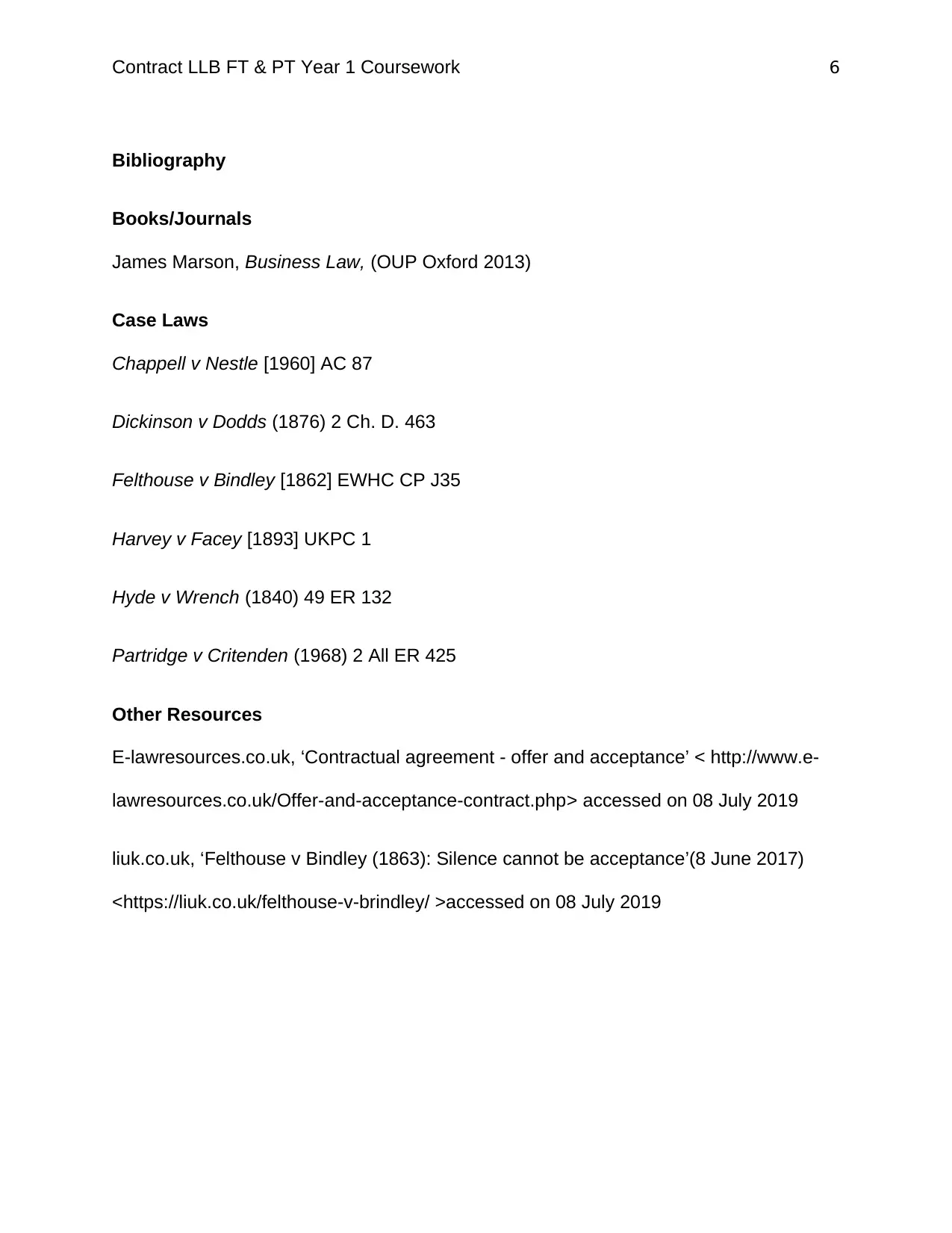
Contract LLB FT & PT Year 1 Coursework 6
Bibliography
Books/Journals
James Marson, Business Law, (OUP Oxford 2013)
Case Laws
Chappell v Nestle [1960] AC 87
Dickinson v Dodds (1876) 2 Ch. D. 463
Felthouse v Bindley [1862] EWHC CP J35
Harvey v Facey [1893] UKPC 1
Hyde v Wrench (1840) 49 ER 132
Partridge v Critenden (1968) 2 All ER 425
Other Resources
E-lawresources.co.uk, ‘Contractual agreement - offer and acceptance’ < http://www.e-
lawresources.co.uk/Offer-and-acceptance-contract.php> accessed on 08 July 2019
liuk.co.uk, ‘Felthouse v Bindley (1863): Silence cannot be acceptance’(8 June 2017)
<https://liuk.co.uk/felthouse-v-brindley/ >accessed on 08 July 2019
Bibliography
Books/Journals
James Marson, Business Law, (OUP Oxford 2013)
Case Laws
Chappell v Nestle [1960] AC 87
Dickinson v Dodds (1876) 2 Ch. D. 463
Felthouse v Bindley [1862] EWHC CP J35
Harvey v Facey [1893] UKPC 1
Hyde v Wrench (1840) 49 ER 132
Partridge v Critenden (1968) 2 All ER 425
Other Resources
E-lawresources.co.uk, ‘Contractual agreement - offer and acceptance’ < http://www.e-
lawresources.co.uk/Offer-and-acceptance-contract.php> accessed on 08 July 2019
liuk.co.uk, ‘Felthouse v Bindley (1863): Silence cannot be acceptance’(8 June 2017)
<https://liuk.co.uk/felthouse-v-brindley/ >accessed on 08 July 2019
1 out of 7
Related Documents
Your All-in-One AI-Powered Toolkit for Academic Success.
+13062052269
info@desklib.com
Available 24*7 on WhatsApp / Email
![[object Object]](/_next/static/media/star-bottom.7253800d.svg)
Unlock your academic potential
Copyright © 2020–2025 A2Z Services. All Rights Reserved. Developed and managed by ZUCOL.





